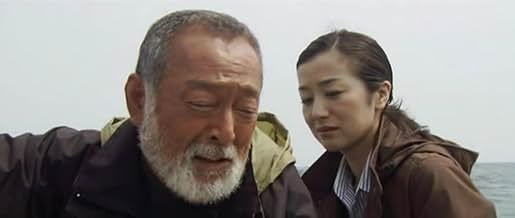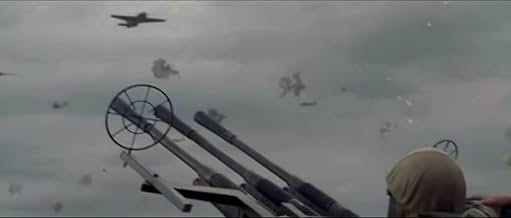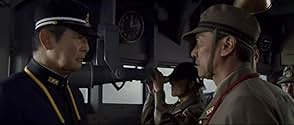Adicionar um enredo no seu idiomaThe movie follows 3 Japanese friends from embarking on Yamato, the world's largest battleship, until it's sunk 3 1/2 years later on April 7, 1945 on it's way to Okinawa to stop American adva... Ler tudoThe movie follows 3 Japanese friends from embarking on Yamato, the world's largest battleship, until it's sunk 3 1/2 years later on April 7, 1945 on it's way to Okinawa to stop American advance at the end of WWII.The movie follows 3 Japanese friends from embarking on Yamato, the world's largest battleship, until it's sunk 3 1/2 years later on April 7, 1945 on it's way to Okinawa to stop American advance at the end of WWII.
- Direção
- Roteiristas
- Artistas
- Prêmios
- 6 vitórias e 7 indicações no total
- Atsushi
- (as Sosuke Ikematsu)
Avaliações em destaque
So this movie once again skips over anything -- Japanese perspective or not -- about the war, and focuses on the only thing Japan has ever focused on since -- their own suffering.
The other thing is that the fight scenes make it look like they are at least making the US pay a heavy price. This is typical Japanese face- saving. If you are going to make a movie about these dead heroes to the state, you have to at least make it look like they died being somewhat competent. In fact, the count for the day was something like 10 US planes downed, and 14 pilots wounded. Considering that 4000 Japanese sailors died, this was an incredibly lopsided fight. So in other words, the battle must have looked very, very different than this movie.
I understand that a Japanese director probably cannot make a movie in which Japanese sailors are dying by the thousands -- and ARE NOT EVEN ABLE to inflict much damage in return. But that isn't US propaganda -- that is what happened. Surely at this point, it's time for someone to tell the young people of Japan something closer to the truth? Yes, Japan paid for its mistake, but it was not an innocent victim.
In 2001 I taught for six weeks in Japan, 2 weeks before, then later 4 weeks after 9/11. My students incredulously asked me in amazement "who would think of using an airplane as a suicide weapon and killing themselves and lots of other people?" They had not even HEARD of kamikazes! I did not have the heart to enlighten them, so I restrained my natural response "Your people invented this!"
Modern pacifist Japan is rooted in ignorance, and this movie contributes nothing to understanding. This is the telling of a war that happened in another dimension, not here. This is a tale from a Japan that still cannot own up to its own history.
I am not racist nor nationalist. I also am not right wing. I oppose to any wars by any mean. But, I respect the men who fought for us and it is sad that we don't know much about the fact we are living on where these men protected.
I voted this as "5" for actors/actress are not that super... Theme song as the same... Understanding they did their best, but level of acting is miserable. The battle scenes are great.
Sometime it's too stereotype to illustrate the story (ie. Geisha & Japanese Gamble ... that's almost the all the Japanese movie does).
Yamato (the old name for Japan) has good and bad points. Starting with the good - I find the story fascinating, how the remainder of the Second fleet made a run for Okinawa on a mission that everyone knew was suicide due to lack of air support (Japan's air force had been finally crushed at Saipan). Some of the acting was great; I thought Uchida really stood out. As far as I can tell the film was very historically accurate. Some of the insights into "bushido" were interesting, especially the admiral's explanation of bushido vs. English chivalry. And some of the effects were pretty good too.
On the bad side... the film had kind of a made-for-TV movie feel. As I said, some of the effects were good, others were far from great. The director shied away from showing the large sections of the ship, or the whole ship, maybe because of lack of budget - but I found myself really wanting to see those shots of this 65,000 ton superbattleship. It was obvious the whole film was made in a studio. They really should have invested in substantial steel tubes for the anti-aircraft guns, the fact that they jittered around like toys bothered me. Also in the silent dialog scenes, there should have been an omnipresent rumble of the ship's engines to add to the illusion that we are on the largest battleship in the world.
It wasn't great, but I enjoyed it anyway, and anyone else who is interested in Japanese naval history I think will also enjoy it despite its shortcomings.
This is a very good and moving film. For all of the clichés (is there a well worn plot device it doesn't have?) it does manage to touch the heart and the head. We really do care about the characters we see up on the screen, and what happens to them, death in a foolish adventure, moves us. At the same time we get to see the waste that is war and was the Japanese war effort in the final days of World War Two. Its made clear that the fight to the end mentality leaves no room for tomorrow. Its best expressed in a simple scene on the bridge of the ship. One of the officers is asked to explain the difference between chivalry, the Western code of war, and Bushido, the Japanese code. Bushido, he says is preparing for a death with no reward, Chivalry is trying to live a noble life. Its a difference that all of the men can see but which very few ever get the chance to live by. Even the survivors, the old man essentially telling the story, is haunted by the fact that he lived and everyone else died.As the film asks plainly, if we all die, who's going to be around to take advantage of our sacrifices? Its a question that needs to be asked in this age of suicide bombers. There is a great many other thematic threads running through this film that lift it out of the typical war movie pile.
The cast is top notch. They manage to take what is often a clichéd script and to infuse it with the power of reality. Modern sequences aside, you care for these people and you are moved by what happens to them. The tears that well up in the final modern scenes come from the fact that the cast of the war sections is so good that you carry over the emotion. I wish that the modern sequences had given the actors something to do other than simply push the story into action.
Technically the film is very impressive. The Yamato, is monster of a ship and its plain to see that great care was taken in recreating it. Its a beautiful movie to look at with the entire film having a wonderful sense of place and time. The two battle scenes are graphic in a way that I've never seen in a naval war film (if you don't like blood you may want to look elsewhere.) This is going to be something to rattle the windows with on DVD.
If the film has any real flaw thats its length. The film is about two and a half hours long and to be honest it probably could have been shorter. I was getting fidgety during some of it. Its not that its bad, its just that the films pace allows you too much time to dwell on some of the by the numbers construction of the plot so you just want the film to get to the next bit (what another tearful goodbye?). It doesn't kill the film, it just makes it hard to truly get lost in the story.
If you like war films, or good movies this is one to keep an eye out for. Just be ready to do a little digging since I'm not sure if this is going to get a regular release outside of Asia.
I found myself with tears in my eyes from the very beginning, because it was as if all the black and white photographs I have been generously shown by these families were coming to life--the young faces of these sailors, frightened, proud, and eager to live up to their responsibilities, were very true to what I sense was really happening in the 1940s.
I have to say, unlike the very propagandist flavor of many American films about the Pacific War, including most recently 'Pearl Harbor,' this film really delves into the traumatic aspects of masculinity in general and having to live up to "being a man" in Japan just as much as it celebrates the humanity of the people involved. Many American films, with the exception of 'Saving Private Ryan' and several films about Vietnam, tend to stick to very comic-like stark depictions of heroes and villains and an overall sense of being "victimized" by the enemy. Here, the enemy is not the United States but rather masculinity and male pride itself, as well as the whole tragic story they create.
As such, it is a welcome remedy to way too much American-biased victory narratives that obscure the face of the Japanese military, and to films that portray menacing, dehumanized battalions of Japanese soldiers advancing forth without any legitimate context of their own. We see in this film the faces of these young men and understand what situation they were coming from.
That said, clearly the film was trying to be sensitive to war bereaved and to the official narratives of Japanese pretexts for war, and in that sense I feel they overdid it a little. We don't get a sense, for instance, about Japan's colonial presence throughout Asia and the Pacific--only the vague notion that Japan somehow got involved in war. Still, this isn't really a film about why the war happened, but rather about how it was to live and fight in the immediate time preceding Japanese surrender. In that sense, I do want to make the critique that this film really could have done with even MORE contextualization and solid research of popular Japanese culture at the time, because this would have added even more to its convincing sense of reality. For instance, the soundtrack would have been greatly enhanced with some of the evocative marching music and the ballads on the radio in the 1930s and 1940s that encouraged young men to join the navy and go south to the South Seas.
These songs are still sung even by the bereaved families who go back to visit the places where their loved ones died, so it would have been quite powerful if we got to hear them throughout the film. The absence of small details like this, some rather poorly-imitated Japanese regional dialects, and some of the melodramatic overacting by a few members of the cast, detracted somewhat from the overall production. But in general, this is a very fine film, extremely well acted (and compassionately so) by its cast.
I have been reading a book about the film in Japanese and it's fascinating to learn how so many of the cast worked directly with Japanese veterans and the bereaved families in order to develop their characters and their behavior. So in many respects this film is not only based on the realities of battle (which are really just the backdrop) but on the real life realities of war and on being a young man in the Japanese Imperial Navy in 1944-1945.
In all, it's an extremely meaningful film that needs to be distributed widely through the world. I know there is a lot of resistance to its release in China and Korea, understandably, but I think this is a portrait of what was going on for Japanese at the time and as such could even work as a tool to facilitate better understanding in these countries. It is essential that more compassionate films like this are made that go on to address the complexity and horror of what happened in Asia and the Pacific-- to the people whose lives were colonized and ruined by Japanese aggression, but at least it's a start. It appears to me that Japanese popular culture is finally ready to address the war in all of its ugliness and begin to heal some of these old wounds.
Você sabia?
- CuriosidadesPart of the foredeck and port side of the Yamato were reconstructed to full scale for the exterior scenes. As the Japan Building Standards Act interfered with re-creating the ship's entire superstructure, images of a one-tenth scale model of the Yamato at its namesake museum in Kure were used in post-production.
- Erros de gravaçãoThe ship is seen firing salvos from its main batteries aimed at approaching US aircraft on several occasions, while lots of the crew are visible on deck, manning the light AA guns as well as performing other duties. While the big guns were in fact used fending off aircraft, at least during the last battle off Okinawa, the shock wave from the blast of the nine 460 mm barrels (the biggest ever on a warship) could kill or severely injure an unprotected sailor, it was therefore forbidden to remain on deck on such occasions.
- Citações
Mamoru Uchida: [Firing an AA gun defiantly as the ship sinks] I'm not done yet! My last throw!
Principais escolhas
- How long is Yamato?Fornecido pela Alexa
Detalhes
- Data de lançamento
- País de origem
- Central de atendimento oficial
- Idioma
- Também conhecido como
- Otoko-tachi no Yamato
- Locações de filme
- Empresas de produção
- Consulte mais créditos da empresa na IMDbPro
Bilheteria
- Faturamento bruto mundial
- US$ 39.287.114
- Tempo de duração
- 2 h 25 min(145 min)
- Cor
- Mixagem de som
- Proporção
- 2.35 : 1











